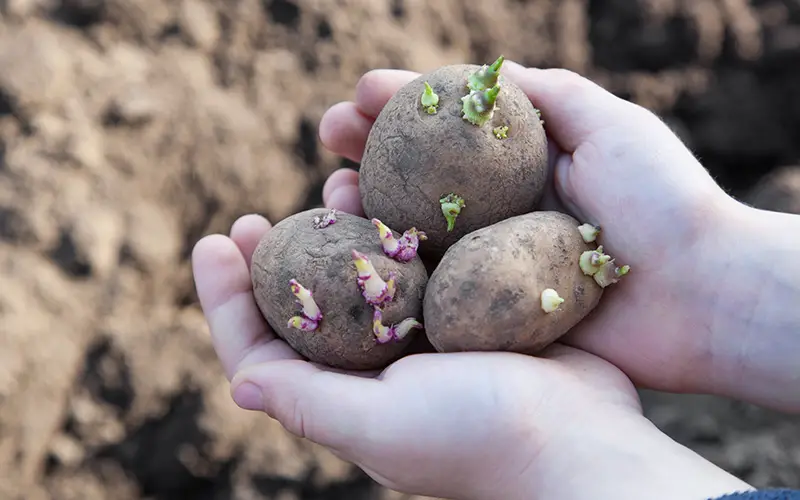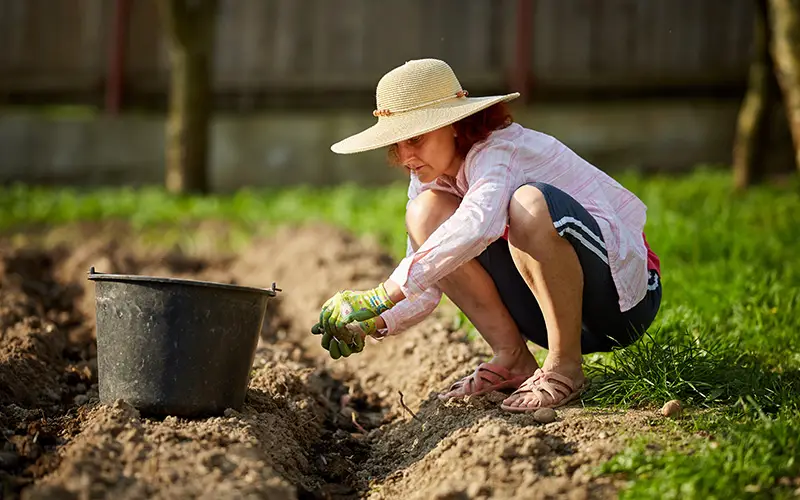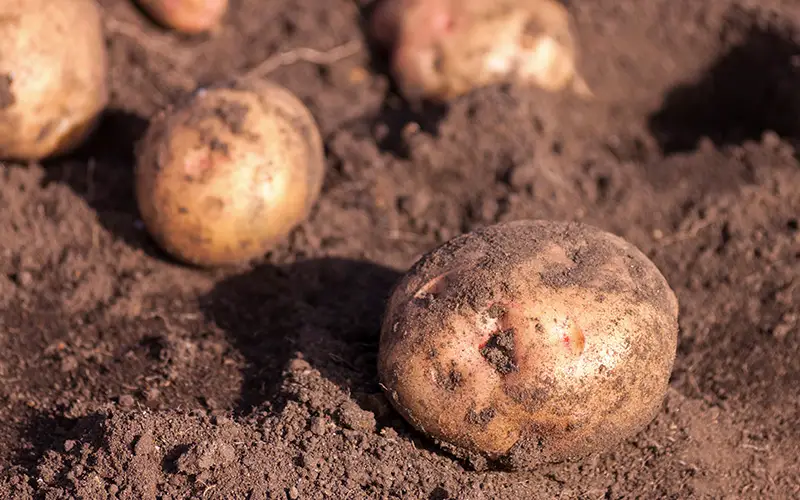Growing your own potatoes can be a rewarding and enjoyable experience, as potatoes are versatile vegetables that play a starring role in many dishes. Whether you have a large garden or a small patio planter, planting potatoes can be relatively simple with the right preparation and knowledge.
To successfully plant potatoes, it is important to choose the ideal location, select quality seed potatoes, and prepare the soil for planting. Additionally, understanding when to plant and how to care for the growing plants can significantly impact the harvest size and health of the potatoes.
In this article, we will discuss the key steps to planting potatoes, from choosing the right time and location to tips on caring for the plants as they grow. By following these guidelines, novice and experienced gardeners alike can enjoy the satisfaction of harvesting their own fresh, homegrown potatoes.

Choosing Seed Potatoes
There are several factors to consider when selecting seed potatoes for your garden. These include the type of potatoes you’d like to grow and their suitability for your specific growing region.
Potato Varieties
Potatoes come in a wide range of varieties, categorized by their skin and flesh color. It’s essential to choose the right kind based on your preference, cooking needs, and local climate. Here are some popular potato varieties:
- Yellow: These potatoes, such as Yukon Gold, have golden skin and flesh, with a creamy texture and rich flavor. They are versatile in the kitchen and can be used for baking, mashing, and frying.
- Red: Red-skinned potatoes, like Red Pontiac and Red LaSoda, have thin red skin and white or yellow flesh. They are suitable for boiling and making potato salads, as they hold their shape well.
- White: White potatoes, such as Kennebec and Katahdin, feature light skin and white flesh. They are ideal for boiling, mashing, and frying, due to their starchy texture.
- Blue: Blue potatoes, like All Blue and Adirondack Blue, have unique blue skin and flesh, with a slightly nutty flavor. They are suitable for baking, mashing, and making colorful dishes.
- Russets: Russet potatoes, such as Burbank and Norkotah, have brown skin and white flesh. Their high starch content makes them ideal for baking, frying, and mashing.
- Long White Potatoes: Long white potatoes, like White Rose and Cascade, have thin skin and white flesh. They are best used for boiling and making potato salads, as they hold their shape well.
When choosing seed potatoes, it’s essential to select certified disease-free options from reputable suppliers. This will help ensure a healthy crop and reduce the likelihood of spreading diseases to your garden.

Preparing the Soil
Soil Temperature
The ideal soil temperature for planting potatoes is between 50°F and 60°F (10°C and 15°C). Planting in soil that is too cool may result in delayed germination and reduced yields, while planting in soil that is too warm may lead to premature sprouting and rotting of the seed potatoes.
Soil Preparation
Begin by choosing a location in your garden with well-draining soil that receives full sun. Potatoes thrive in nutrient-rich, loose sandy loamy soil with a pH of 5.5 to 6.5, which is considered slightly acidic. Before planting, test the pH of your soil using a soil test kit. If the pH is too high, add sulfur to lower it, while adding lime to raise it if the pH is too low (source).
Next, incorporate 3-4 inches of well-rotted compost or aged manure into the existing soil to improve its nutrient content and structure. This will provide the potatoes with a good supply of nitrogen and potash, essential elements for healthy growth (source). Mix the organic matter into the soil using a garden fork or tiller.
To ensure proper aeration and moisture retention, loosen the soil up to a depth of 12 inches by turning it over several times. This will help prevent the formation of lumps and allow the potato roots to penetrate the soil more easily. It is essential to remove any stones, debris, or large clumps that may hinder the growth and development of the potatoes (source).
In summary, preparing the soil for planting potatoes involves checking for the correct soil temperature, adjusting the soil pH if necessary, incorporating organic matter for improved fertility, and loosening the soil for proper aeration and moisture retention.

Planting Potatoes
Planting potatoes is a rewarding and relatively simple process that allows gardeners to enjoy home-grown produce. This section of the article will cover spacing and depth, as well as the optimal planting time for potatoes.
Spacing and Depth
One of the most important factors to consider when planting potatoes is the spacing between the plants and the depth at which they are placed. First, prepare the soil by ensuring it is weed-free and suitable for growing.[source]
Next, dig a trench using a shovel or hoe, about 3 to 4 inches deep, and place the seed potatoes in it with the “eyes” (sprouts) facing up. It is crucial to space the seed potatoes about a foot apart to give each plant enough room to grow and develop.[source] For traditional row plantings, maintain a distance of about 3 to 4 feet between the rows to ensure proper growth.[source]
Planting Time
Timing is key for planting potatoes, as the success of the crop depends largely on the growing season, soil temperature, and the occurrence of frost. Ideally, potatoes should be planted 2 to 4 weeks before the average last frost date in the region.[source]
It’s essential to keep an eye on soil temperature, as it should be at least 55°F during the day and 45°F at night for prime planting conditions. If the soil is too wet and clumps together, wait for it to dry out somewhat before planting.[source]
While early spring is generally the best time for planting, some gardeners may also plant in the fall for a late-season harvest, avoiding late frosts in the process. In either case, monitoring soil temperature and weather conditions remains crucial for success.[source]

Caring for Growing Potatoes
Proper care for growing potatoes involves ensuring adequate water, controlling weeds, and hilling the soil. These steps will ensure a healthy and bountiful harvest.
Watering
Watering is essential for potato growth. Potatoes require consistent moisture in the soil to grow and develop correctly. In general, they need about 1 to 2 inches of water per week, either from rain or irrigation. Monitor the soil moisture to avoid over-watering or underwatering, as this may lead to issues such as rot or reduced yield. In the flowering stage, potatoes require more water, so pay close attention to their needs during this crucial growth period.
Weeding
Weed control is necessary for the healthy growth of potato plants. Weeds compete with potato plants for nutrients, water, and sunlight. Regular weeding, either by hand or with a hoe, will help keep the potato plants healthy and ensure they receive the resources needed for optimal growth. A layer of mulch around the potato plants can limit weed growth and also helps maintain adequate soil moisture.
Hilling
Hilling, or mounding the soil around the base of the potato plants, is an essential practice for promoting healthy growth. Hilling keeps the developing tubers covered, which protects them from sunlight and maintains even soil temperature. Begin hilling when the potato plants are about 6 inches tall and continue hilling every 2 to 3 weeks as the plants grow. Hilling also aids in controlling weeds and promoting proper aeration around the potato plants.
Pest and Disease Management
Managing pests and diseases is crucial for a successful potato harvest. In this section, we’ll cover common pests and diseases that affect potatoes along with tips to mitigate their damage.
Common Pests
The following are common pests that may cause harm to your potato plants:
- Aphids: These small insects can damage potato plants by sucking their sap and potentially transmitting viruses. To control aphids, you may introduce beneficial insects, such as ladybugs, or use insecticidal soap to treat the affected plants. (source)
- Potato Beetles: The Colorado potato beetle is notorious for damaging potato plants. Hand-picking, using floating row covers, and introducing natural predators can help keep beetle populations in check.
Common Diseases
Potatoes can be affected by various diseases, including:
- Potato Blight: This fungal disease causes dark, water-soaked spots on potato leaves, eventually leading to leaf drop and reduced yield. Crop rotation and choosing disease-resistant varieties can help prevent potato blight.
- Scab: Scab is caused by a soil-dwelling bacterium that affects potato tubers, causing unsightly lesions. To manage scab, maintain a slightly acidic soil pH, avoid overwatering, and practice crop rotation. (source)
It’s important to be aware of the fact that potatoes are part of the nightshade family, which also includes tomatoes, peppers, and eggplants. To reduce the risk of disease transmission between these related plants, avoid planting them in the same area in consecutive years.
Harvesting and Storing Potatoes
When to Harvest
Potatoes can be harvested at different stages, depending on their intended use. New potatoes can be harvested as early as two weeks after the plant has finished flowering(source). For fully mature potatoes, wait until the plant’s foliage turns yellow and starts to die back. This usually occurs within 75 to 135 frost-free days after planting, depending on the variety(source).
How to Harvest
To harvest potatoes, choose a dry day for the best results. Carefully dig around the plant, starting about a foot away from the base, and gently lift the potatoes out of the soil. Be cautious not to pierce or damage the tubers during the process. Once harvested, brush off any excess soil and let the potatoes air-dry for a short period of time, avoiding direct sunlight.
Storing Potatoes
Before storing potatoes, allow them to cure in a dark, cool, and well-ventilated area for about 7 to 10 days. This helps to heal any cuts or bruises that may have occurred during the harvest(source). After the curing process, store potatoes in a dark, cool, and humid environment, such as a root cellar or a cardboard box. Ideal storage conditions are as follows:
- Temperature: 40 to 45°F (4.4 to 7.2°C)
- Humidity: 90 to 95% relative humidity
- Darkness: Exposure to light can cause potatoes to turn green and produce solanine, a toxic compound
Regularly check on stored potatoes and remove any that show signs of spoilage to prevent the spread of rot to other tubers.
